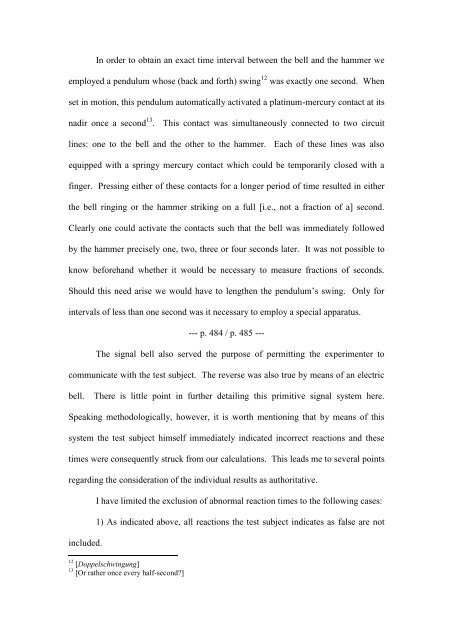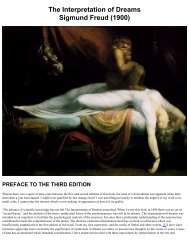Lange, L - Classics in the History of Psychology
Lange, L - Classics in the History of Psychology
Lange, L - Classics in the History of Psychology
Create successful ePaper yourself
Turn your PDF publications into a flip-book with our unique Google optimized e-Paper software.
In order to obta<strong>in</strong> an exact time <strong>in</strong>terval between <strong>the</strong> bell and <strong>the</strong> hammer we<br />
employed a pendulum whose (back and forth) sw<strong>in</strong>g 12 was exactly one second. When<br />
set <strong>in</strong> motion, this pendulum automatically activated a plat<strong>in</strong>um-mercury contact at its<br />
nadir once a second 13 . This contact was simultaneously connected to two circuit<br />
l<strong>in</strong>es: one to <strong>the</strong> bell and <strong>the</strong> o<strong>the</strong>r to <strong>the</strong> hammer. Each <strong>of</strong> <strong>the</strong>se l<strong>in</strong>es was also<br />
equipped with a spr<strong>in</strong>gy mercury contact which could be temporarily closed with a<br />
f<strong>in</strong>ger. Press<strong>in</strong>g ei<strong>the</strong>r <strong>of</strong> <strong>the</strong>se contacts for a longer period <strong>of</strong> time resulted <strong>in</strong> ei<strong>the</strong>r<br />
<strong>the</strong> bell r<strong>in</strong>g<strong>in</strong>g or <strong>the</strong> hammer strik<strong>in</strong>g on a full [i.e., not a fraction <strong>of</strong> a] second.<br />
Clearly one could activate <strong>the</strong> contacts such that <strong>the</strong> bell was immediately followed<br />
by <strong>the</strong> hammer precisely one, two, three or four seconds later. It was not possible to<br />
know beforehand whe<strong>the</strong>r it would be necessary to measure fractions <strong>of</strong> seconds.<br />
Should this need arise we would have to leng<strong>the</strong>n <strong>the</strong> pendulum‟s sw<strong>in</strong>g. Only for<br />
<strong>in</strong>tervals <strong>of</strong> less than one second was it necessary to employ a special apparatus.<br />
--- p. 484 / p. 485 ---<br />
The signal bell also served <strong>the</strong> purpose <strong>of</strong> permitt<strong>in</strong>g <strong>the</strong> experimenter to<br />
communicate with <strong>the</strong> test subject. The reverse was also true by means <strong>of</strong> an electric<br />
bell. There is little po<strong>in</strong>t <strong>in</strong> fur<strong>the</strong>r detail<strong>in</strong>g this primitive signal system here.<br />
Speak<strong>in</strong>g methodologically, however, it is worth mention<strong>in</strong>g that by means <strong>of</strong> this<br />
system <strong>the</strong> test subject himself immediately <strong>in</strong>dicated <strong>in</strong>correct reactions and <strong>the</strong>se<br />
times were consequently struck from our calculations. This leads me to several po<strong>in</strong>ts<br />
regard<strong>in</strong>g <strong>the</strong> consideration <strong>of</strong> <strong>the</strong> <strong>in</strong>dividual results as authoritative.<br />
<strong>in</strong>cluded.<br />
I have limited <strong>the</strong> exclusion <strong>of</strong> abnormal reaction times to <strong>the</strong> follow<strong>in</strong>g cases:<br />
1) As <strong>in</strong>dicated above, all reactions <strong>the</strong> test subject <strong>in</strong>dicates as false are not<br />
12 [Doppelschw<strong>in</strong>gung]<br />
13 [Or ra<strong>the</strong>r once every half-second?]



